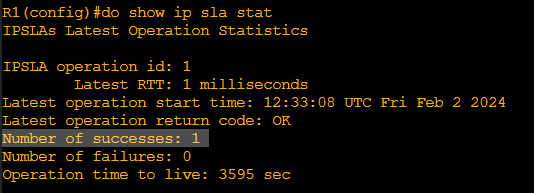Hello, everyone!
I have a few questions to confirm. I am not quite sure whether the timeout vs threshold explanation is 100% correct.
I don’t think that anything that goes above the threshold is considered a failure.
I’ve configured the timeout to be 100 seconds while the threshold was set to 100 ms which is a significantly lower value.
To summarize and provide more clarity, here’s my configuration.

The operation timeout is set to 100 seconds
The operation frequency is set to 100 seconds
The operation threshold is set to 100 milliseconds
R1 is connected to R2 (192.168.12.2). This is an icmp-echo operation which is used for basic connectivity verification. Once I schedule it, the first packet is successsful.

Since the frequency is set to 100 seconds, the next packet should be sent once the operation ttl hits 3500 seconds. However, I will shut down the link between R1 and R2 to break the connectivity.
After 100 seconds, another packet is sent.
However, notice that the number of failures does not increment, despite the threshold being already exceeded (20 seconds have passed since this packet was sent).
The operation is considered as failed and the counter increments only after the timeout (100 seconds) expires.

From how I understand the threshold, it’s a value that once exceeded, the administrator can configure the device to take a specific action, such as generate an SNMP trap. It’s basically “this is taking a bit too long, let’s raise some alarms” value.
Laz or Rene, can you confirm this please and verify my understanding? Thank you!




